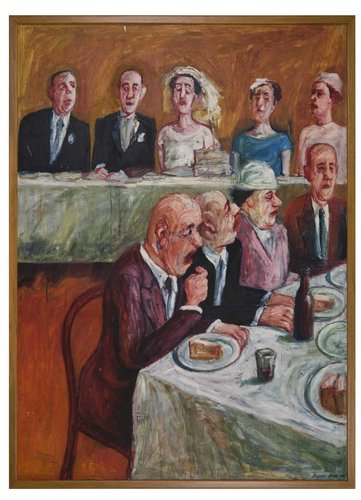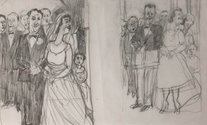Peter Ireland – 5 May, 2016
It's too tempting to write off these works as merely caricatures from a brief moment in time by a rookie artist, and too easy just to place them in the tradition of Hogarth, Gilray and Rowlandson, savagely mocking prevailing social mores. Of course, their expressionist style, social realism and narrative content were not at all fashionable in the early 1960s, so as a body of work it was at right angles to mainstream New Zealand practice of the time.
Napier
Bryan Dew
Bryan Dew & the panorama of social unease: paintings and drawings
Curated by Douglas Lloyd Jenkins
15 April 2014 - 7 July 2016
“Small but perfectly formed” is a phrase combining both apology and redemption. Its use is almost invariably a form of mild irony. But occasionally it’s an exact and just description of a set of very particular circumstances. In terms of exhibitions, it happens rarely, because institutions especially need to make a big splash to attract viewers and justify funding. But when it does happen, it’s nearly always a memorable surprise.
Instances include the revelatory ‘50s gouaches by Gordon Walters at McLeavey’s in 1974, Christina Barton’s Louise Henderson “cubist” works at the Auckland Art Gallery in 1991, Karl Chitham’s Liquid Dreams, contemporary watercolours at the Dowse in 2010, Sandy Callister’s carte-de-visite and albums show at the Adam Gallery in 2011, and Reuben Friend’s Guerilla Girls at Wellington’s City Gallery in 2011. Wellington gallerist Robert Heald is routinely good at such shows, as is Kathlene Fogarty at FHE in Auckland. Everyone can come up with their own favourites and recall them with justifiable pleasure.
The name Bryan Dew is not one that resonates much in accounts of New Zealand art. If it hadn’t been for McCahon organising the Auckland Art Gallery to buy Dew’s 1963 Jubilee in 1969 and Gil Docking including a black and white image of it (1) in his long-running history of painting here, the artist may have dropped completely out of sight. As it was, his most focused painting production occurred over only a short, intense period, and his residence in New Zealand lasted only a little longer. A small, insecure culture tends to reward such perceived lack of commitment and loyalty by writing the artist out of the script. The revenge of the village.
Dew was born in in Hastings in 1940 and after leaving school went to Elam where he graduated in 1961, the following year spent at Auckland Teachers’ College. The works in this show come from the period 1960 to 1963 (2). Around 1963 he left New Zealand on an Arts Council scholarship to study graphic art and design in London at the Royal College of Art Design School, and in 1966 travelled to the US to continue his studies at Indiana University, after which he moved to New York where he worked as a graphic designer, living there for the rest of his life, dying in 2006. Latterly his art work showed, formally, the significant influence of his professional graphic design, but never without his grounding in social relations or his early life in Hawkes Bay. He described his relationship to this country as “obsessive” and once said “New Zealand is the subject I think about every day above all others in New York.”
It was standard practice in those days for for artists to travel “overseas”, usually to Europe and mostly to England, to advance their studies and sup from the great gravy dish of European culture. Some stayed, like Bill Culbert and Douglas MacDiarmid; others “came home” - like Pat Hanly, Melvin Day and John Drawbridge. But, like Len Lye, Dew headed for New York and stayed. His was a love/hate relationship with New Zealand and it seemed he wanted to get as far away as possible. Geographically, of course, London was further, but socially and artistically New York was. Simply, New Zealand was too stultifying for him.
In the later 1980s Hawkes Bay art critic and curator Roy Dunningham approached Dew about arranging a survey of his work, an exhibition called Rear View Mirror opening in 2005 - the year before his death - at the then Hawkes Bay Exhibition Centre in Hastings, now the Hastings City Art Gallery. This marked the beginnings of a new interest in Dew’s work.
At Napier’s MTG last year there was a collection show upstairs at the time of the Dew show’s opening, an exhibition including a Fomison painting entitled Agony in the Garden (1983), referencing the historical tradition of depicting Christ in the Garden of Gethsemene the night before his crucifixion, praying to God the Father to spare him this all-too-daunting experience. But a more plausible and perhaps relevant agony in the garden was taking place downstairs. In one of his last ventures as MTG director Douglas Lloyd Jenkins curated a small but intense exhibition of paintings and drawings by Dew, the show installed in a small, fairly narrow “walk through” gallery on the ground floor, but admirably suited to it.
It’s too tempting to write off these works as merely caricatures from a brief moment in time by a rookie artist, and too easy just to place them in the tradition of Hogarth, Gilray and Rowlandson, savagely mocking prevailing social mores. Of course, their expressionist style, social realism and narrative content were not at all fashionable in the early 1960s, so as a body of work it was at right angles to mainstream New Zealand practice of the time. And it’s not easy now to recall just how isolated internationally this country was then, and how much it was still in the grip of the world-view, the aspirations and conformities of the British Empire.
These works are the fruit of Dew’s frustration with - and, ultimately, rejection of - these very conditions, and their enduring value is as a vivid testament to a passionate colonial artist’s dilemma: a deep fondness for the country of his birth but a loathing for its condition. His skewering of social conventions, his revelation of shallowness and spiritual malaise in the fallen pudding faces of his depicted men and women - not so much wearing their “best” as passively imprisoned by clothing - are unforgettable images of a conformist, confining and unimaginative culture. The very impasto and strong colour of the oil paintings suggest a stirred-up, angry soup - even the materiality of the works bringing the painter’s inner frustration to visual birth. The great surprise, though, are the four related drawings - preparatory sketches for some of the paintings - small miracles of structure and tonality, of a delicacy giving no hint as to the brutal paintings to come.
Now that the accepted art practices of the early 1960s are able to be viewed and reassessed in their historical context, what were formerly seen as limitations in Drew’s work now emerge as strengths. His social focus, personal concerns and use of narrative are mirrored widely in the practice and projects of contemporary 21st century artists. Our art history has seldom seen the production of a series of such focused, coherent and sustained work in a period as short as three years as Dew’s, driven by a genuine albeit conflicted passion and a self-knowledge rare in those days, and rare enough even now. Cezanne’s serene registering of his sensations before nature is grungingly paralleled by Drew’s fierce registration of his sensations before culture.
Peter Ireland
(1) Gil Docking, Two Hundred Years of New Zealand Painting, Wellington, A H & A W Reed, 1971, p.140. The 2012 edition, titled 240 Years of New Zealand Painting, reproduces this painting in colour on p.142.
(2) The show consists of 8 paintings, all approximately a standard 2.0 m x 1.0 m, 4 drawings from the Estate of Don Binney, and 1 lithograph.







 Two Rooms presents a program of residencies and projects
Two Rooms presents a program of residencies and projects Advertising in this column
Advertising in this column



This Discussion has 0 comments.
Comment
Participate
Register to Participate.
Sign in
Sign in to an existing account.